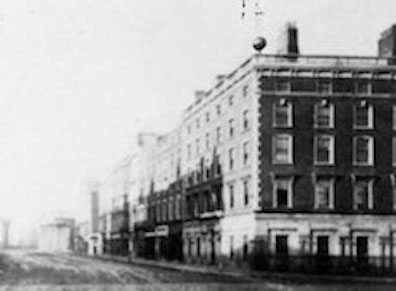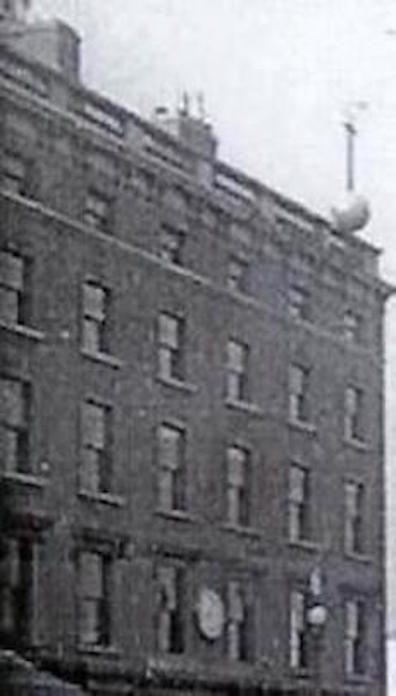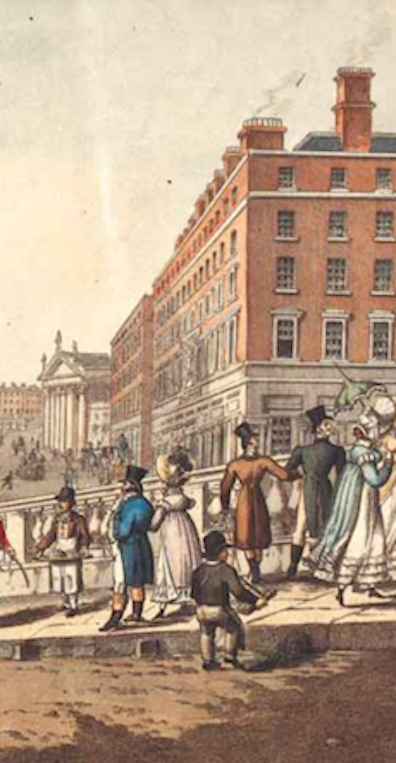The Joyce Project : Ulysses : Ballast Office
Ballast Office
Ballast Office
In Brief
Looking south from the O'Connell bridge in Lestrygonians, Bloom sees the four-story Ballast Office, which stood at the corner of Aston Quay where Westmoreland Street begins running south from the river. The building served as a reliable timekeeper for the City and the Port of Dublin. Over the front door, on the outside wall of the second story, perched a large clock known for accuracy. On the northeast corner of the building's roof a large copper ball descended every day at 1:00. Bloom sees that the ball has fallen: "After one. Timeball on the ballastoffice is down. Dunsink time." He is wrong about the Dunsink time, but he corrects his mistake later in the chapter.
Read More
The copper ball, four feet in diameter, had a wooden pole through its center, allowing it to be raised and lowered. Gifford notes that it was rigged close to the river "so that ships' chronometers could be checked" (accurate chronometers were vital for calculating longitude at sea). The time ball dropped each day at 1:00 PM Greenwich Mean Time, the international standard. Ireland, however, was on Dunsink time, 25 minutes and 21 seconds behind Greenwich time. This time was determined by the Dunsink Observatory north of Phoenix Park and communicated directly to the Ballast Office by a five-mile telegraph wire. The observatory time (wired also to Trinity College, the General Post Office, and the Bank of Ireland) was accurate to within one second per week.
From seeing that the ball has come down, Bloom judges that the time is "After one." But on Irish time the ball fell just before 12:35. If he were to walk down Westmoreland Street and look at the clock on the building's wall, it might display some time earlier than 1:00. Later in Lestrygonians, returning to his earlier thoughts, he remembers that the ball and the clock show different times: "Now that I come to think of it, that ball falls at Greenwich time. It's the clock is worked by an electric wire from Dunsink."
In Cyclops the Ballast Office puts in one more brief appearance as the Flotilla Bloom floats majestically down the Liffey toward open water: "Amid cheers that rent the welkin, responded to by answering cheers from a big muster of henchmen on the distant Cambrian and Caledonian hills, the mastodontic pleasureship slowly moved away saluted by a final floral tribute from the representatives of the fair sex who were present in large numbers while, as it proceeded down the river, escorted by a flotilla of barges, the flags of the Ballast office and Custom House were dipped in salute as were also those of the electrical power station at the Pigeonhouse and the Poolbeg Light." The Custom House sits across the river, and slightly downstream, from the site of the Ballast Office.
The Ballast Office was owned by the Dublin Port and Docks Board, the governing entity which had replaced the Ballast Board in 1876. The Board maintained offices on the ground and top floors, while the second and third floors held the offices of Irish Shipping Limited. This building, with its time ball on the roof for the benefit of shipping interests, was a vital commercial hub in the days when oceangoing ships could sail up the Liffey all the way to Carlisle (O'Connell) Bridge.
Today the docks do not reach so far upriver. The Port and the City have become substantially separate entities, and the Ballast Office was demolished in the 1970s to make room for a new office block. However, the builders erected a "pastiche" replica of the old building's facade to conceal the new one.


